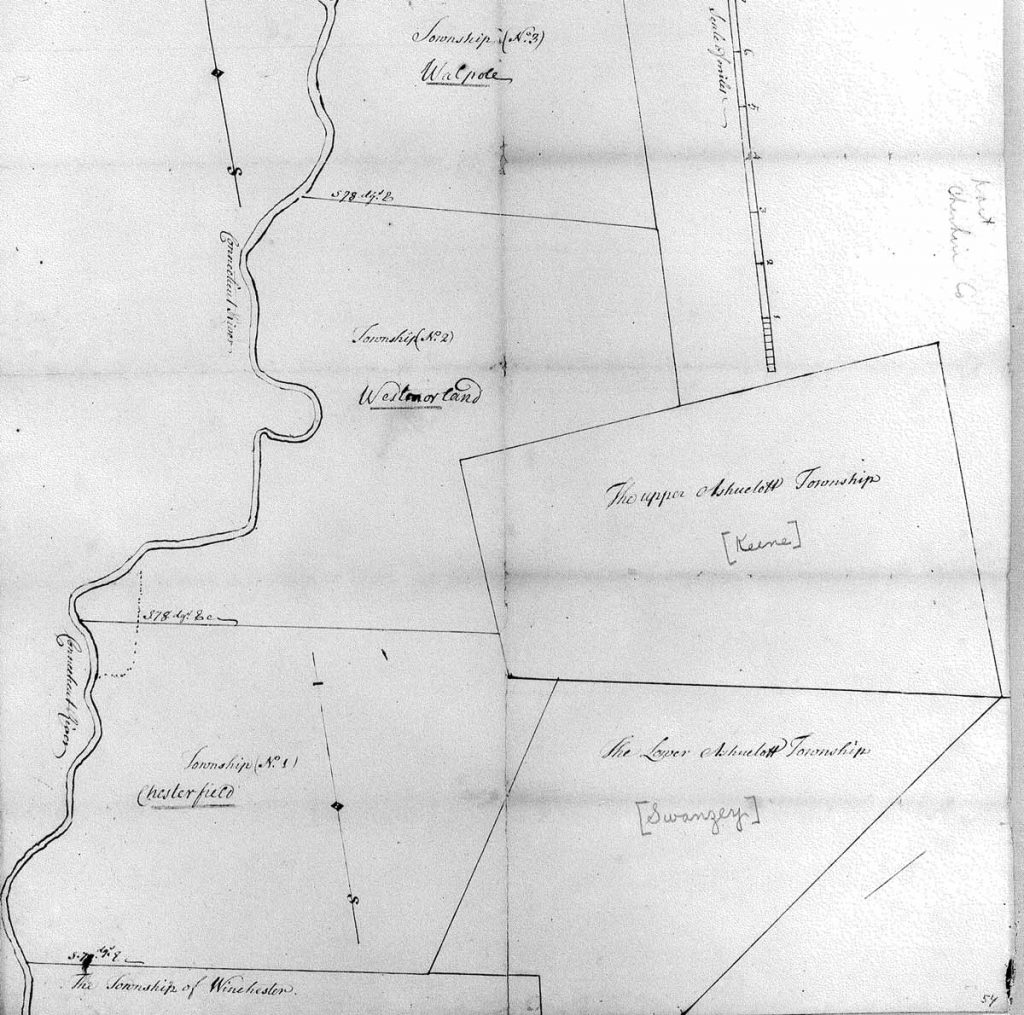Upper Ashuelot Township
1652
Prior to receiving the town name Keene, the land was referred to as the Upper Township on the Ashuelot River, or Upper Ashuelot. The land was granted to settlement by Massachusetts. According to historical document The History of the Town of Keene by Griffin in 1652 Massachusetts sent out surveyors to explore the land of what is now New Hampshire.
1732

Map of five Massachusetts Towns Circe 1750 Unknown name, Unknown Date, hard copy located at the State Archives in Concord, NH
On June 1st 1732, Massachusettes’ Governer Belcher began a conversation to “settle the ungranted lands”. Belcher proposed 7 townships be granted in Mass. including two townships on the Ashuelot River above Northfield. The conversation concluded July 3rd 1732 when The House of Representatives granted establishment of three townships, including two towns along the Ashuelot River above Northfield.
1736
The conversation lead to a surveying group to explore the land before actually breaking ground on housing developments. Finally, Nathan Blake erects the first house in the upper Township on the Ashuelot River in 1736. All of the houses built prior to the French and Indian Wars would be burnt to the ground.
Battles in Keene Leading up to French and Indian Wars
1745
When the war began in 1745 settlement of the Upper Ashuelot Township (Now known as Keene) halted. The settlement was abandoned for some time to focus development efforts on defense from French and Indian Raids. Defense efforts were made at several forests along the Connecticut River. These forts were in Northfield, Hinsdale, Brattleboro, Chesterfield, Westmoreland, Walpole, and Charlestown (Griffin, 65). Agriculture was too dangerous of an activity during the war. The Griffin quote below describes the first French and Indian Raid in Upper Ashuelot in 1745.
On the 5th of July, as William Phipps was hoeing his corn,
he was seized by two Indians … Watching his opportunity,
Phipps with his hoe knocked down the one who remained,
giving him a death blow; then, seizing his gun, shot the
other as he came up. Starting to escape he fell into the
hands of three others of the same party who killed and
scalped him. Five days later they made their first appearance
here at Upper Ashuelot.“On the 10th of July, deacon Josiah Fisher was killed,
as he was driving his cow to pasture… Fisher was found dead, and scalped, in the
road, near where Mr. Lamson’s bark house now stands;
and it was supposed, that the Indian who shot him, was
concealed behind a log, which then lay within the present
limits of Mr. Lamson’s garden. He had a brass slug in
his wrist, which, at the time, was conjectured to have
been cut from a warming pan, that had lately been lost
by one of the inhabitants.” (Annals, page 18.)
After this occurrence in Charlestown, NH, in 1745 around 100 “Saint Frances Indians” raided Upper Ashuelot alongside the French. They burned down several houses and fields. They captured Nathan Blake, whom the town myth of Keene is based upon. English relief was eventually sent from Lower Ashuelot (Now known as Swanzey) and they found the remains of burnt bodies of English Settlers and Indians. They sent out a search party for Nathan Blake, but only found a horse belonging to a neighbor of Blake’s. This is perhaps the bloodiest event that Keene has ever seen.
1746
The English settlers that remained protecting Upper Ashuelot were not equipped to defend against the forest offensive tactics of the Indians. Massachusetts had been protecting these lands. New Hampshire at the time, had very much overlooked these lands and did not provide adequate protection. in 1746 The troops in Upper Ashueolt were recalled to Massachusetts.
1749
At some point Upper Ashuelot, Lower Ashuelot, and Winchester were completely abandoned. The settlers had left to seek safety from Indian Attacks. Settlers had returned to Upper Ashuelot in 1749. New Hampshire refused to grant township of the settlement because it would be a expensive. However, a township for Keene was eventually granted in 1753 by the New Hampshire Governor .
1754
1754 French and Indian Wars Occur, the Township at Upper Ashuelot is left empty by Englishmen while they take cover in Fort Dummer of the west side of the Connecticut River near Brattleboro, Fort Hill, where the Ashuelot River meets the Connecticut River, and the Fort at No. 4 in Charlestown, NH on the Connecticut River. The French and Indian War Ended in 1760.
See Next: The New Hampshire Charter